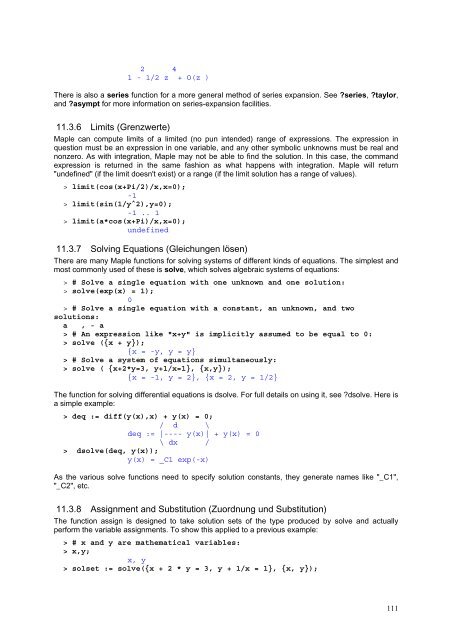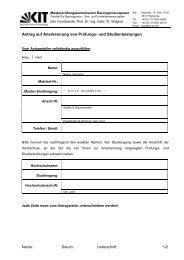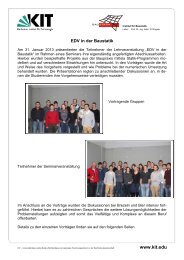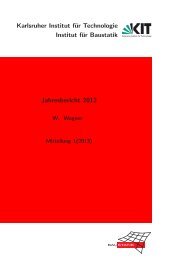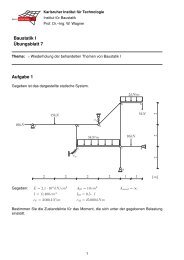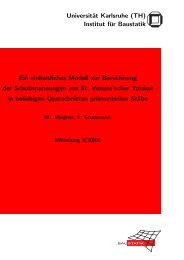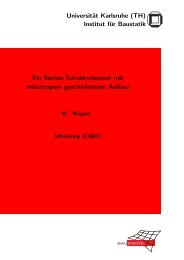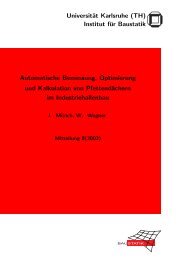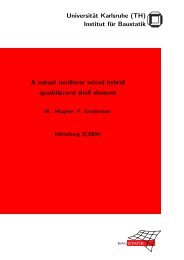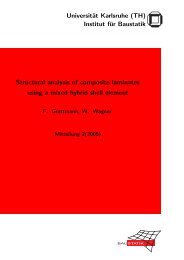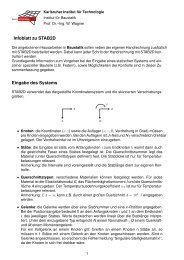PDF-Version - am Institut für Baustatik
PDF-Version - am Institut für Baustatik
PDF-Version - am Institut für Baustatik
Erfolgreiche ePaper selbst erstellen
Machen Sie aus Ihren PDF Publikationen ein blätterbares Flipbook mit unserer einzigartigen Google optimierten e-Paper Software.
2 4<br />
1 - 1/2 z + O(z )<br />
There is also a series function for a more general method of series expansion. See ?series, ?taylor,<br />
and ?asympt for more information on series-expansion facilities.<br />
11.3.6 Limits (Grenzwerte)<br />
Maple can compute limits of a limited (no pun intended) range of expressions. The expression in<br />
question must be an expression in one variable, and any other symbolic unknowns must be real and<br />
nonzero. As with integration, Maple may not be able to find the solution. In this case, the command<br />
expression is returned in the s<strong>am</strong>e fashion as what happens with integration. Maple will return<br />
"undefined" (if the limit doesn't exist) or a range (if the limit solution has a range of values).<br />
> limit(cos(x+Pi/2)/x,x=0);<br />
-1<br />
> limit(sin(1/y^2),y=0);<br />
-1 .. 1<br />
> limit(a*cos(x+Pi)/x,x=0);<br />
undefined<br />
11.3.7 Solving Equations (Gleichungen lösen)<br />
There are many Maple functions for solving systems of different kinds of equations. The simplest and<br />
most commonly used of these is solve, which solves algebraic systems of equations:<br />
> # Solve a single equation with one unknown and one solution:<br />
> solve(exp(x) = 1);<br />
0<br />
> # Solve a single equation with a constant, an unknown, and two<br />
solutions:<br />
a , - a<br />
> # An expression like "x+y" is implicitly assumed to be equal to 0:<br />
> solve ({x + y});<br />
{x = -y, y = y}<br />
> # Solve a system of equations simultaneously:<br />
> solve ( {x+2*y=3, y+1/x=1}, {x,y});<br />
{x = -1, y = 2}, {x = 2, y = 1/2}<br />
The function for solving differential equations is dsolve. For full details on using it, see ?dsolve. Here is<br />
a simple ex<strong>am</strong>ple:<br />
> deq := diff(y(x),x) + y(x) = 0;<br />
/ d \<br />
deq := |---- y(x)| + y(x) = 0<br />
\ dx /<br />
> dsolve(deq, y(x));<br />
y(x) = _C1 exp(-x)<br />
As the various solve functions need to specify solution constants, they generate n<strong>am</strong>es like "_C1",<br />
"_C2", etc.<br />
11.3.8 Assignment and Substitution (Zuordnung und Substitution)<br />
The function assign is designed to take solution sets of the type produced by solve and actually<br />
perform the variable assignments. To show this applied to a previous ex<strong>am</strong>ple:<br />
> # x and y are mathematical variables:<br />
> x,y;<br />
x, y<br />
> solset := solve({x + 2 * y = 3, y + 1/x = 1}, {x, y});<br />
111


